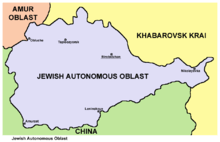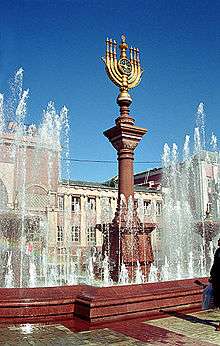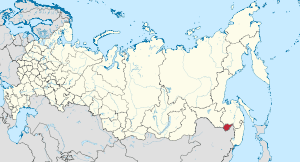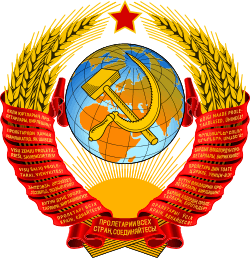Jewish Autonomous Oblast
| Jewish Autonomous Oblast Еврейская автономная область (Russian) | |||
|---|---|---|---|
| — Autonomous oblast — | |||
| |||
|
| |||
| |||
|
| |||
| Political status | |||
| Country | Russia | ||
| Federal district | Far Eastern[2] | ||
| Economic region | Far Eastern[3] | ||
| Established | May 7, 1934[4] | ||
| Administrative center | Birobidzhan | ||
| Government (as of July 2014) | |||
| • Governor[5] | Alexander Levintal[6] | ||
| • Legislature | Legislative Assembly[7] | ||
| Statistics | |||
| Area (as of the 2002 Census)[8] | |||
| • Total | 36,000 km2 (14,000 sq mi) | ||
| Area rank | 61st | ||
| Population (2010 Census)[9] | |||
| • Total | 176,558 | ||
| • Rank | 80th | ||
| • Density[10] | 4.9/km2 (13/sq mi) | ||
| • Urban | 67.6% | ||
| • Rural | 32.4% | ||
| Population (January 2014 est.) | |||
| • Total | 170,377[11] | ||
| Time zone(s) | VLAT (UTC+10:00)[12] | ||
| ISO 3166-2 | RU-YEV | ||
| License plates | 79 | ||
| Official languages | Russian[13] | ||
| Official website | |||
The Jewish Autonomous Oblast (Russian: Евре́йская автоно́мная о́бласть, Yevreyskaya avtonomnaya oblast; Yiddish: ייִדישע אווטאָנאָמע געגנט, yidishe avtonome gegnt[14]) is a federal subject of Russia (an autonomous oblast) in the Russian Far East, bordering Khabarovsk Krai and Amur Oblast in Russia and Heilongjiang province in China. It is also referred to as "Yevrey"[15] (Yiddish: יעװרײ) and "Birobidzhan"[16] (Yiddish: ביראָבידזשאַן). Its administrative center is the town of Birobidzhan. As of the 2010 Census, JAO's population was 176,558,[9] making 0.1% of the Russia's total population. The JAO is Russia's only autonomous oblast[17] and, aside from Israel, the world's only Jewish territory with an official status.
Soviet authorities established the autonomous oblast in 1934. It was the result of Soviet nationality policy under Stalin, which provided the Jewish population of the Soviet Union with a territory in which to pursue Yiddish cultural heritage.[18] According to the 1939 population census, 17,695 Jews lived in the region (16% of the total population). The Jewish population peaked in 1948 at around 30,000, about one-quarter of the region's population.[19]
In 1953, Joseph Stalin died and thereafter the Jewish population in the JAO began a long decline. The census of 1959 found that the Jewish population of the JAO had declined by approximately 50%, down to 14,269 persons.[20] In 2002, there were 2,327 people of Jewish descent living in the JAO (1.2% of the total population), while ethnic Russians made up 90% of the JAO population. A 2007 article in the Jerusalem Post claimed that, at the time, approximately 4,000 Jews remain in the JAO.[21] According to Mordechai Scheiner, the Chief Rabbi of the JAO from 2002 to 2011, Judaism and the Jewish culture in the oblast have recently begun enjoying a religious and cultural resurgence.[21] However, according to the magazine of the Federation of Jewish Communities of the CIS Lechaim, currently the Jewish presence in the Jewish Autonomous Oblast is extremely small, and is limited to the city of Birobidzhan and the nearby village of Valdgeym.[22] By 2010, according to data provided by the Russian Census Bureau, there were only 1,628 people of Jewish descent remaining in the JAO (1% of the total population), while ethnic Russians made up 92.7% of the JAO population.[23] According to data provided by the Russian Census Bureau, 97 persons spoke Yiddish, 312 persons spoke Hebrew, and a further 54 persons spoke unspecified Jewish languages.[24]
Geography
Climate
The territory has a monsoonal/anti-cyclonic climate, with warm, wet, humid summers due to the influence of the East Asian monsoon; and cold, dry, windy conditions prevailing in the winter months courtesy of the Siberian high-pressure system.
History
Military colonization and the advent of the Trans-Siberian Railway
The northern bank of the Amur, including the territory of today's Jewish Autonomous Oblast, became incorporated into the Russian Empire pursuant to the treaties of Aigun and Peking of 1858-1860 (see Amur Annexation).
In December 1858 the Russian government authorized formation of the Amur Cossacks to protect the southeast boundary of Siberia and communications on the Amur and Ussuri rivers. This military colonization included settlers from Transbaikalia. During the years 1858–82, sixty three settlements were founded, including, in 1857, Radde settlement; in 1858, Pashkovo, Pompeyevka, Puzino, Yekaterino-Nikolskoye, Mikhailo-Semyonovskoye, Voskresenovka, Petrovskoye, and Ventzelevo; in 1860, Storozhevoye, Soyuznoye, and Golovino; later in the decade, Babstovo, Bidzhan, and Bashurovo settlements. Expeditions of scientists — including such geographers, ethnographers, naturalists, and botanists as Venyukov, Schrenck, Maximovich, Radde, and Komarov - promoted the development of the new territories. Their achievements produced the first detailed "map of the Amur land".

Construction began in 1898 on the Trans-Siberian Railway connecting Chita and Vladivostok, starting at each end and meeting halfway. The project produced a large influx of new settlers and the foundation of new settlements. In 1908 Volochayevka, Obluchye, and Bira, Russia stations appeared; in 1910, Birakan, Londoko, and In stations; in 1912, Tikhonkaya station. The railway construction finished in October 1916 with the opening of the 2,590-meter (8,500 ft) Khabarovsk Bridge across the Amur at Khabarovsk. In the pre-revolutionary period most local inhabitants were farmers. The only industrial enterprise was the Tungussky timber mill, although gold was mined in the Sutara River, and there were some small railway workshops. During the civil war, the territory of the future Jewish Autonomous Oblast was the scene of terrible battles. The economy declined, though it was recovering in 1926 and 1927.
Jewish settlement and development in the region
Originally the plan was to settle the Jews in Ukraine and Crimea, but local opposition made the governmental committees look elsewhere. Finally Birobidzhan was chosen.[25] Two Jewish districts (raiony) were formed in Crimea and three in south Ukraine.[26]
On March 28, 1928, the Presidium of the General Executive Committee of the USSR passed the decree "On the attaching for Komzet of free territory near the Amur River in the Far East for settlement of the working Jews." The decree meant "a possibility of establishment of a Jewish administrative territorial unit on the territory of the called region".[27][28] In the future, based on JAO was supposed to create a Jewish republic (as a place of compact residence of the Jews of the USSR), but this plan was never implemented.[29]
On August 20, 1930 the General Executive Committee of RSFSR accepted the decree "On formation of the Birobidzhan national region in the structure of the Far Eastern Territory". The State Planning Committee considered the Birobidzhan national region as a separate economic unit. In 1932 the first scheduled figures of the region development were considered and authorized.[28] The Organization for Jewish Colonisation in the Soviet Union, a Jewish Communist organization in North America, successfully encouraged the immigration of some US residents, such as the family of George Koval, which arrived in 1932.[30] Some 1,200 non-Soviet Jews chose to settle in Birobidzhan.[31]
On May 7, 1934, the Presidium of the General Executive Committee accepted the decree on its transformation into the Jewish Autonomous Region within the Russian Federation. In 1938, with formation of the Khabarovsk Territory, the Jewish Autonomous Region (JAR) was included in its structure.[28]
According to Joseph Stalin's national policy, each of the national groups that formed the Soviet Union would receive a territory in which to pursue cultural autonomy in a socialist framework. In that sense, it also responded to two supposed threats to the Soviet state:
- Judaism, which ran counter to official state policy of atheism
- Zionism — the advocacy of a Jewish national state in Palestine — which countered Soviet views of nationalism.
The Soviets envisaged setting up a new "Soviet Zion", where a proletarian Jewish culture could be developed. Yiddish, rather than Hebrew, would be the national language, and literature and the arts would replace religion as the primary expression of culture.
Stalin's theory on the National Question regarded a group as a nation only if it had a territory, and since there was no Jewish territory, per se, the Jews were not a nation and did not have national rights. Jewish Communists argued that the way to solve this ideological dilemma was by creating a Jewish territory, hence the ideological motivation for the Jewish Autonomous Oblast. Politically, it was also considered desirable to create a Soviet Jewish homeland as an ideological alternative to Zionism and the theory put forward by Socialist Zionists such as Ber Borochov that the Jewish Question could be resolved by creating a Jewish territory in Palestine. Thus Birobidzhan was important for propaganda purposes as an argument against Zionism which was a rival ideology to Marxism among left-wing Jews.
Another important goal of the Birobidzhan project was to increase settlement in the remote Soviet Far East, especially along the vulnerable border with China. The region was often infiltrated by the Chinese; in 1927, Shiang-Kai-Shek had ended cooperation with the Chinese Communist Party, which further increased the threat. Japan also seemed willing and ready to detach the Far Eastern provinces from the USSR. In the mid-1920s, there were only about 30,000 inhabitants, mostly descendants of Trans-Baikal Cossacks planted there by tsarist authorities, Koreans, Kazakhs, and a primitive tribe called the Tungus.[32] Birobidzhan had a harsh geography and climate: it was mountainous, covered with virgin forests of oak, pine and cedar, and also swamplands, and any new settlers would have to build their lives from scratch. To make colonization more enticing, the Soviet government allowed private land-ownership. This led to many non-Jews settling in the oblast to get a free farm.[33]
By the 1930s, a massive propaganda campaign developed to induce more Jewish settlers to move there. The campaign partly incorporated the standard Soviet propaganda tools of the era and included posters and Yiddish-language novels describing a socialist utopia there. In one instance, leaflets promoting Birobidzhan were dropped from an airplane over a Jewish neighborhood in Belarus. In another instance, a government-produced Yiddish film called Seekers of Happiness told the story of a Jewish family that made a new life for itself in Birobidzhan.
As the Jewish population grew, so did the impact of Yiddish culture on the region. Settlers established a Yiddish newspaper, the Birobidzhaner Shtern; a theater troupe was created; and streets being built in the new city were named after prominent Yiddish authors such as Sholom Aleichem and Y. L. Peretz. The Yiddish language was deliberately bolstered as a basis for efforts to secularize the Jewish population and, despite the general curtailment of this action as described immediately below, the Birobidzhaner Shtern continues to publish a section in Yiddish.[34]

Valdgeym, a Jewish settlement within the Jewish Autonomous Oblast,[35] dates from 1928 and formed the first collective farm established in the oblast.[36] In 1980 a Yiddish school was opened in the settlement.[37] Amurzet also has a history of Jewish settlement in the JAO.[38][39] For the period 1929 through 1939, this village was the center of Jewish settlement south of Birobidzhan.[40] The present day Jewish community members hold Kabalat Shabbat ceremonies and gatherings that feature songs in Yiddish, Jewish cuisine, and broad information presenting historical facts on Jewish culture. Many descendants of the founders of this settlement, which was established just after the turn of the 20th century, have left their native village. Those who remained in Amurzet, especially those having relatives in Israel, are learning about the traditions and roots of the Jewish people.[41] The population of Amurzet, as estimated in late 2006, is 5,213.[42] Smidovich is another early Jewish settlement in the JAO.
World War II era (1930s and 1940s)
The Jewish population of JAO reached a pre-war peak of 20,000 in 1937.[29] The Birobidzhan experiment ground to a halt in the mid-1930s, during Stalin's first campaign of purges. Soviet authorities arrested and executed Jewish leaders, and Yiddish schools were shut down. Shortly after this, World War II brought an abrupt end to concerted efforts to bring Jews east.
After the war ended in 1945, there was renewed interest in the idea of Birobidzhan as a potential home for Jewish refugees. The Jewish population peaked in 1948 at around 30,000, about one-quarter of the region's population. Stalin's anti-Jewish purges that same year essentially criminalized Jewish activities.[19]
Events since 1991

In 1991, the Jewish Autonomous Oblast moved from the jurisdiction of Khabarovsk Krai to the jurisdiction of the Federation; however, by that time, most of the Jews had emigrated from the Soviet Union and the remaining Jews now constituted fewer than two percent of the local population. Nevertheless, Yiddish is once again taught in the schools, a Yiddish radio station is in operation, and the Birobidzhaner Shtern includes a section in Yiddish.[43]
L'Chayim, Comrade Stalin!, a documentary on Stalin's creation of the Jewish Autonomous Region and its settlement, was released by The Cinema Guild in 2002, in addition to being a history of the creation of the Jewish Autonomous Oblast, the film features scenes of contemporary Birobidzhan and interviews with Jewish residents.[44]
There is a proposal to merge JAO with Khabarovsk Krai.[45][46] Another suggestion was to merge it with Amur Oblast to form the Amur region.[46] The proposals caused many objections from amongst local JAO groups and residents, and also protests in the Jewish community of Russia.[47] The presidential envoy to the Far Eastern Federal District Viktor Ishayev advocated merging JAO into Khabarovsk Krai,[46] but believed the merger is currently premature.[48][49] Amongst the citizens of the JAO, there is nearly uniform opposition to such a merger, yet neighboring oblasts more generally support the prospect of such a merger.[50]
Administrative divisions
Economy
The Jewish Autonomous Oblast is part of the Far Eastern Economic Region; it has well-developed industry and agriculture and a dense transportation network. Its status as a free economic zone increases the opportunities for economic development. The oblast's rich mineral and building and finishing material resources are in great demand on the Russian market. Nonferrous metallurgy, engineering, metalworking, and the building material, forest, woodworking, light, and food industries are the most highly developed industrial sectors.[51]
Agriculture is the Jewish Autonomous Oblast's main economic sector owing to fertile soils and a moist climate.
Transportation
The region's well-developed transportation network consists of 530 km of railways, including the Trans-Siberian Railway; 600 km of waterways along the Amur and Tunguska rivers; and 1900 km of roads, including 1600 km of paved roads. The most important road is the Khabarovsk-Birobidzhan-Obluchye-Amur Region highway with ferry service across the Amur. The Birobidzhan Yuzhniy Airfield located in the center of the region connects Birobidzhan with Khabarovsk and outlying district centers. There are also plans to establish international air service between Birobidzhan and Jiamusi in China.[51]
Amur Bridge Project
In 2007, Russian mining interests, in consortium with the Chinese government, announced the possibility of the construction of a rail-bridge link between the two countries across the Amur River at Nizhneleninskoye. In the years since the initial proposal for the bridge, various proposed construction start dates have been first announced, and then postponed/ discarded. The bridge would link Nizhneleninskoye in the Jewish Autonomous Oblast with Tongjiang in Heilongjiang Province.[52] The 2,197-meter-long bridge would require an estimated investment of nearly US$230 million, Gurevich said.[53] As of 2013, construction on the project had not yet begun.
Demographics
Population: 176,558 (2010 Census);[9] 190,915 (2002 Census);[54] 215,937 (1989 Census).[55]
The 2010 Census reported the largest group to be the 160,185 ethnic Russians (92.7%), followed by 4,871 ethnic Ukrainians (2.8%), and 1,628 ethnic Jews (1%).[9] Additionally, 3,832 people were registered from administrative databases, and could not declare an ethnicity. It is estimated that the proportion of ethnicities in this group is the same as that of the declared group.[56]
- Vital statistics for 2012
- Births: 2 445 (14.0 per 1000)
- Deaths: 2 636 (15.1 per 1000) [57]
Total fertility rate:[58]
2009 - 1.67 | 2010 - 1.67 | 2011 - 1.79 | 2012 - 1.84 | 2013 - 1.86 | 2014 - 1.95 | 2015 - 2.02
Religion
According to a 2012 official survey[59] 22.6% of the population of the Jewish Autonomous Oblast adhere to Russian Orthodoxy, 6% are Orthodox Christians of other church jurisdictions or Orthodox believers who aren't members of any church, and 9% are unaffiliated or generic Christians. Judaism is practiced by 0.2% of the population. In addition, 35% of the population identify as "spiritual but not religious", 22% profess atheism, and 5.2% follow other religions or declined to answer the question.[59]
Education
The Birobidzhan Jewish National University works in cooperation with the local Jewish community of Birobidzhan. The university, uniquely in the Russian Far East and the Far East as a whole, uses as the basis of its teaching the study of the Hebrew language, history and classic Jewish texts.[61]
In recent years, the Jewish Autonomous Oblast has grown interested in its Jewish roots. Students study Hebrew and Yiddish at a Jewish school and at the Birobidzhan Jewish National University. In 1989, the Jewish center founded its Sunday school, where children study Yiddish, learn Jewish folk dances, and memorize dates from the history of Israel. The Israeli government helps fund the program.[62]
Birobidzhan has several state-run schools that teach Yiddish, a Yiddish school for religious instruction and a kindergarten. The five- to seven-year-olds spend two lessons a week learning to speak Yiddish, as well as being taught Jewish songs, dance, and traditions.[63] Today, the city’s fourteen public schools must teach Yiddish and Jewish tradition. The school Menora was created in 1991. It is a public school that offers a half-day Yiddish and Jewish curriculum for those parents who choose it. About half the school’s 120 pupils are enrolled in the Yiddish course. Many of them continue on to Public School No. 2, which offers the same half-day Yiddish/Jewish curriculum from first through twelfth grades. Yiddish also is offered at Birobidzhan’s Pedagogical Institute, one of the few university-level Yiddish courses in the country.[64]
In 2007 Yiddish studies professor Boris Kotlerman of Bar-Ilan University launched "the First Birobidzhan International Summer Program for Yiddish Language and Culture".[65]
See also
- Beit T'shuva
- Boris "Dov" Kaufman
- History of the Jews in Russia
- History of the Jews in the Soviet Union
- In Search of Happiness
- History of the Jews in the Jewish Autonomous Oblast
- List of Chairmen of the Legislative Assembly of the Jewish Autonomous Oblast
- East Asian Jews
- Yevsektsiya
- Proposals for a Jewish state
- Far Eastern Railway (of former Baikal-Amur (BAM) project)
References
Notes
- ↑ While Article 7 of the Charter of the Jewish Autonomous Oblast states that the autonomous oblast has its own anthem, the entries submitted for the 2011–2012 anthem creation contest were of such a low quality that no anthem had ultimately been adopted.
- ↑ Президент Российской Федерации. Указ №849 от 13 мая 2000 г. «О полномочном представителе Президента Российской Федерации в федеральном округе». Вступил в силу 13 мая 2000 г. Опубликован: "Собрание законодательства РФ", №20, ст. 2112, 15 мая 2000 г. (President of the Russian Federation. Decree #849 of May 13, 2000 On the Plenipotentiary Representative of the President of the Russian Federation in a Federal District. Effective as of May 13, 2000.).
- ↑ Госстандарт Российской Федерации. №ОК 024-95 27 декабря 1995 г. «Общероссийский классификатор экономических регионов. 2. Экономические районы», в ред. Изменения №5/2001 ОКЭР. (Gosstandart of the Russian Federation. #OK 024-95 December 27, 1995 Russian Classification of Economic Regions. 2. Economic Regions, as amended by the Amendment #5/2001 OKER. ).
- ↑ Charter of the Jewish Autonomous Oblast, Article 4
- ↑ Charter of the Jewish Autonomous Oblast, Article 22
- ↑ Official website of the Jewish Autonomous Oblast. Alexander Borisovich Levintal, Governor of the Jewish Autonomous Oblast (Russian)
- ↑ Charter of the Jewish Autonomous Oblast, Article 15
- ↑ Федеральная служба государственной статистики (Federal State Statistics Service) (2004-05-21). "Территория, число районов, населённых пунктов и сельских администраций по субъектам Российской Федерации (Territory, Number of Districts, Inhabited Localities, and Rural Administration by Federal Subjects of the Russian Federation)". Всероссийская перепись населения 2002 года (All-Russia Population Census of 2002) (in Russian). Federal State Statistics Service. Retrieved 2011-11-01.
- 1 2 3 4 Russian Federal State Statistics Service (2011). "Всероссийская перепись населения 2010 года. Том 1" [2010 All-Russian Population Census, vol. 1]. Всероссийская перепись населения 2010 года (2010 All-Russia Population Census) (in Russian). Federal State Statistics Service. Retrieved June 29, 2012.
- ↑ The density value was calculated by dividing the population reported by the 2010 Census by the area shown in the "Area" field. Please note that this value may not be accurate as the area specified in the infobox is not necessarily reported for the same year as the population.
- ↑ Jewish Autonomous Oblast Territorial Branch of the Federal State Statistics Service. Утвержденная оценка численности постоянного населения на 1 января 2014 года и в среднем за 2013 год (Russian)
- ↑ Правительство Российской Федерации. Федеральный закон №107-ФЗ от 3 июня 2011 г. «Об исчислении времени», в ред. Федерального закона №271-ФЗ от 03 июля 2016 г. «О внесении изменений в Федеральный закон "Об исчислении времени"». Вступил в силу по истечении шестидесяти дней после дня официального опубликования (6 августа 2011 г.). Опубликован: "Российская газета", №120, 6 июня 2011 г. (Government of the Russian Federation. Federal Law #107-FZ of June 31, 2011 On Calculating Time, as amended by the Federal Law #271-FZ of July 03, 2016 On Amending Federal Law "On Calculating Time". Effective as of after sixty days following the day of the official publication.).
- ↑ Official on the whole territory of Russia according to Article 68.1 of the Constitution of Russia.
- ↑ In standard Yiddish: ייִדישע אױטאָנאָמע געגנט, yidishe oytonome gegnt
- ↑ http://www.britannica.com/EBchecked/topic/653112/Yevrey
- ↑ http://www.yivoencyclopedia.org/article.aspx/Birobidzhan
- ↑ Constitution of the Russian Federation, Article 65
- ↑ "The National and State Structure". USSR '86 Yearbook. Novosti Press Agency. 1986.
- 1 2 James Brook, Birobidzhan Journal;A Promised Land in Siberia? Well, Thanks, but ..., The New York Times, July 11, 1996
- ↑ "Всесоюзная перепись населения 1959 года. Национальный состав населения по регионам России". Демоскоп. Retrieved 2008-11-28.
- 1 2 Yiddish returns to Birobidzhan
- ↑ журнал «Лехаим». Борис Котлерман. Биробиджан, или ЕврейскаЯ автономнаЯ область?
- ↑ "Информационные материалы об окончательных итогах Всероссийской переписи населения 2010 года". Retrieved 2013-04-19.
- ↑ "Статистический бюллетень "Национальный состав и владение языками, гражданство населения Еврейской автономной области"" [Statistical Bulletin "National structure and language skills, citizenship population Jewish Autonomous Region"] (RAR, PDF) (in Russian). Russian Federal State Statistics Service. 30 October 2013. In document "5. ВЛАДЕНИЕ ЯЗЫКАМИ НАСЕЛЕНИЕМ ОБЛАСТИ.pdf".
- ↑ Birobidzhan - the Almost Soviet Jewish Autonomous Region, February 2004, retrieved 8 September 2015.
- ↑ Yaacov Ro'i (2004). Jews and Jewish Life in Russia and the Soviet Union. Frank Cass&Co, Ltd. p. 193.
- ↑ Maroney, Eric (2010). The Other Zions : the Lost Histories of Jewish Nations (2009 ed.). Lanham: Rowman & Littlefield Publishers. p. 140. ISBN 978-1442200456.
- 1 2 3 Establishment and Development of the JAR Jewish Autonomous Region official government website. Accessed 2007-08-30.
- 1 2 А. И. Солженицын. Двести лет вместе
- ↑ Michael Walsh George Koval: Atomic Spy Unmasked Smithsonian (magazine) May 2009
- ↑ Arthur Rosen, [www./75mag/birobidzhan/birobidzhan.htm], February 2004
- ↑ Nora Levin (1990). The Jews in the Soviet Union Since 1917: Paradox of Survival, Volume 1. New York University Press. p. 283.
- ↑ Richard Overy (2004). The Dictators: Hitler's Germany, Stalin's Russia. W.W Norton Company, Inc. p. 567.
- ↑ "Birobidzhaner Shtern in Yiddish". Gazetaeao.ru. Archived from the original on October 26, 2011. Retrieved 30 August 2010.
- ↑ "Jewish Autonomous Oblast". Travel East Russia. Retrieved 2009-02-18.
- ↑ "Stalin's forgotten Zion: the harsh realities of Birobidzhan". Swarthmore.
- ↑ Pinkus, Benjamin (1990). "The Post-Stalin period, 1953–83". The Jews of the Soviet Union: the History of a national minority. Cambridge University Press. p. 272. ISBN 978-0-521-38926-6. Retrieved 2009-02-18.
- ↑ "Amurzet, Russia map". Travel Post. Retrieved 2009-02-18.
- ↑ "Festive Mood Mounts For Jews In Russia's Far East". Birobidjan, Russia: The Federation of Jewish Communities of the CIS. 24 November 2004. Retrieved 2009-02-18.
- ↑ "A Jew Receives State Award in Jewish Autonomous Republic". Birobidjan, RU: The Federation of Jewish Communities of the CIS. 31 August 2004. Retrieved 2009-02-18.
- ↑ "Remote Far East Village Mobilizes for Purim". Birobidjan, Russia: The Federation of Jewish Communities of the CIS. 10 March 2005. Retrieved 2009-02-18.
- ↑ "Population of Amurzet".
- ↑ Jewish life revived in Russia, The Washington Times, January 7, 2006
- ↑ Kehr, Dave (January 31, 2003). "FILM REVIEW; When Soviet Jews Sought Paradise in Siberian Swamps and Snow". The New York Times.
- ↑ "Полит-НН.Ру". Парад объединений (in Russian). Polit-nn.ru. Retrieved 2013-04-19.
- 1 2 3 "Интервью газете "Ведомости". Виктор Ишаев предлагает объединить Хабаровский край с Амурской областью, ЕАО и Сахалином". Primamedia.ru. Retrieved 2013-04-19.
- ↑ "Открытая электронная газета "Forum.msk.ru". Еврейская общественность возражает против упразднения Еврейской автономной области". Forum-msk.org. Retrieved 2013-04-19.
- ↑ "Новотека. Полпред президента назвал преждевременным присоединение Еврейской автономии к Хабаровскому краю". Novoteka.ru. Retrieved 2013-04-19.
- ↑ "Новости Хабаровска. ДВ регионам не грозит объединение". Moigorod.ru. Retrieved 2013-04-19.
- ↑ Руководители районов области не видят смысла в объединении ЕАО и Хабаровского края
- 1 2 "Jewish Autonomous Region". Kommersant Moscow. Kommersant. Publishing House. March 5, 2004. Retrieved December 22, 2011.
- ↑ Jia, Bian (2007-06-19). "Proposed bridge to boost bilateral trade". China Daily. p. 20.
- ↑ Dong, Bei (2007-06-18). "China-Russia Trade to Top US$40b". Peking, CN: China Daily. Retrieved 2009-03-06.
- ↑ Russian Federal State Statistics Service (May 21, 2004). "Численность населения России, субъектов Российской Федерации в составе федеральных округов, районов, городских поселений, сельских населённых пунктов – районных центров и сельских населённых пунктов с населением 3 тысячи и более человек" [Population of Russia, Its Federal Districts, Federal Subjects, Districts, Urban Localities, Rural Localities—Administrative Centers, and Rural Localities with Population of Over 3,000] (XLS). Всероссийская перепись населения 2002 года [All-Russia Population Census of 2002] (in Russian). Retrieved August 9, 2014.
- ↑ Demoscope Weekly (1989). "Всесоюзная перепись населения 1989 г. Численность наличного населения союзных и автономных республик, автономных областей и округов, краёв, областей, районов, городских поселений и сёл-райцентров" [All Union Population Census of 1989: Present Population of Union and Autonomous Republics, Autonomous Oblasts and Okrugs, Krais, Oblasts, Districts, Urban Settlements, and Villages Serving as District Administrative Centers]. Всесоюзная перепись населения 1989 года [All-Union Population Census of 1989] (in Russian). Институт демографии Национального исследовательского университета: Высшая школа экономики [Institute of Demography at the National Research University: Higher School of Economics]. Retrieved August 9, 2014.
- ↑ "Перепись-2010: русских становится больше". Perepis-2010.ru. 2011-12-19. Retrieved 2013-04-19.
- ↑ "Естественное движение населения в разрезе субъектов Российской Федерации". Gks.ru. Retrieved 2013-04-19.
- ↑ http://www.gks.ru/wps/wcm/connect/rosstat_main/rosstat/ru/statistics/publications/catalog/doc_1137674209312
- 1 2 3 Arena - Atlas of Religions and Nationalities in Russia. Sreda.org
- ↑ 2012 Survey Maps. "Ogonek", № 34 (5243), 27/08/2012. Retrieved 24-09-2012.
- ↑ "39 registered religious organizations are operating in the region in 2007, December 1". Birobidzhan, RU: Jewish Autonomous Region official government website. 2008. Retrieved 2009-02-18.
- ↑ Working, Russell (14 January 2000). "Jewish oblast retains identity despite emigration". Birobidzhan, Russia: Vladivostok News. Retrieved 18 February 2009.
- ↑ Steen, Michael (2000-01-12). "Soviet-era Jewish homeland struggles on". Kulanu. Reuters. Retrieved 2009-02-18.
- ↑ Fishkoff, Sue (2004-09-16). "In Stalin's ex-Jewish homeland, it's think Yiddish and act Yiddish". Birobidzhan, Russia: NCSJ. Jewish Telegraphic Agency. Retrieved 2009-02-18.
- ↑ "The 2nd Birobidzhan International Summer Yiddish Program". 2all.co.il. 2008. Retrieved 2009-03-06.
Sources
- №40-ОЗ 8 октября 1997 г. «Устав Еврейской автономной области», в ред. Закона №819-ОЗ от 25 ноября 2015 г. «О внесении изменений в статью 19 Устава Еврейской автономной области». Вступил в силу со дня официального опубликования. Опубликован: "Биробиджанская звезда", №125 (15577), 4 ноября 1997 г. (#40-OZ October 8, 1997 Charter of the Jewish Autonomous Oblast, as amended by the Law #819-OZ of November 25, 2015 On Amending Article 19 of the Charter of the Jewish Autonomous Oblast. Effective as of the official publication date.).
Further reading
- American Committee for the Settlement of Jews in Birobidjan, Birobidjan: The Jewish Autonomous Territory in the USSR. New York: American Committee for the Settlement of Jews in Birobidjan, 1936.
- Melech Epstein, The Jew and Communism: The Story of Early Communist Victories and Ultimate Defeats in the Jewish Community, USA, 1919-1941. New York: Trade Union Sponsoring Committee, 1959.
- Henry Frankel, The Jews in the Soviet Union and Birobidjan. New York: American Birobidjan Committee, 1946.
- Masha Gessen, Where the Jews Aren’t: The Sad and Absurd Story of Birobidzhan, Russia’s Jewish Autonomous Region, 2016.
- Ber Boris Kotlerman and Shmuel Yavin, Bauhaus in Birobidzhan. Tel Aviv: Bauhaus Center, 2009.
- Nora Levin, The Jews in the Soviet Union Since 1917: Paradox of Survival: Volume 1. New York: New York University Press, 1988.
- James N. Rosenberg, How the Back-to-the-Soil Movement Began: Two Years of Blazing the New Jewish "Covered Wagon" Trail Across the Russian Prairies. Philadelphia: United Jewish Campaign, 1925.
- Anna Shternshis, Soviet and Kosher: Jewish Popular Culture in the Soviet Union, 1923-1939. Bloomington, IN: Indiana University Press, 2006.
- Henry Felix Srebrnik, Dreams of Nationhood: American Jewish Communists and the Soviet Birobidzhan Project, 1924-1951. Boston: Academic Studies Press, 2010.
- Robert Weinberg, Stalin's Forgotten Zion: Birobidzhan and the Making of a Soviet Jewish Homeland: An Illustrated History, 1928-1996. Berkeley, CA: University of California Press, 1998.
External links
| Wikimedia Commons has media related to Jewish Autonomous Oblast. |
- Official website of the Jewish Autonomous Oblast
- Stalin's Forgotten Zion: Birobidzhan and the Making of a Soviet Jewish Homeland: An Illustrated History, 1928-1996
- Official website of the new musical "Soviet Zion" set in Birobidzhan
- (Russian) Birobidzhan: Dream of a Jewish Homeland That Never Came True by Eve-Maria Stolberg (Russian Archipelago)
- A 1939 Soviet pamphlet about the JAO
- Meeting of the Frontiers: The Birobidzhan Album (1920's-1930's photographs of Birobidzhan)
- EAO.ru
 |
|
|
|
 |
| Heilongjiang, |
|
| ||
| ||||
| | ||||
| Heilongjiang, |
Heilongjiang, |
Heilongjiang, |




